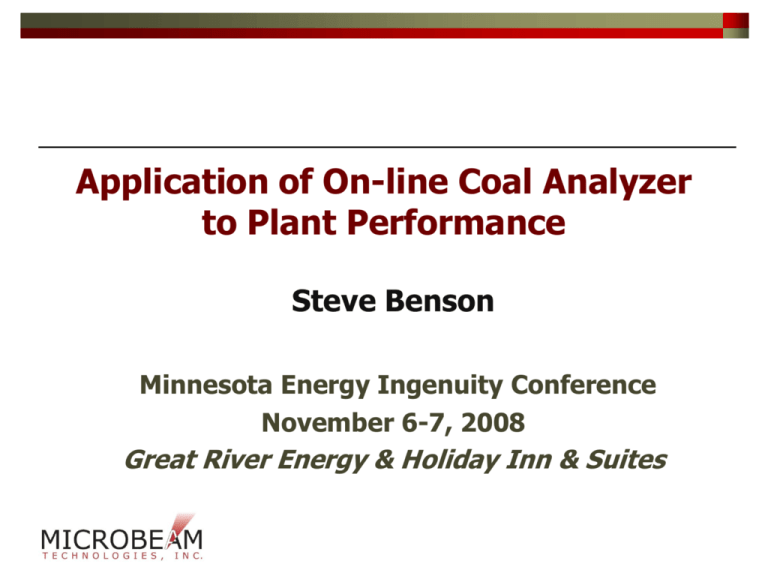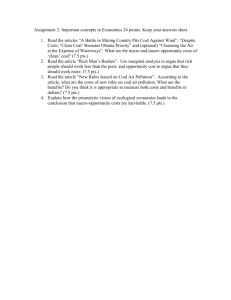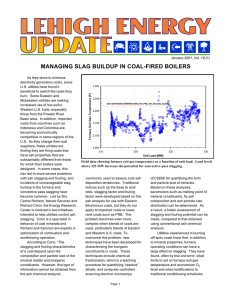Microbeam Technologies, Inc.
advertisement

Application of On-line Coal Analyzer to Plant Performance Steve Benson Minnesota Energy Ingenuity Conference November 6-7, 2008 Great River Energy & Holiday Inn & Suites Presentation Overview Background on Microbeam Technologies Inc. Fuel quality challenges for existing and future power systems Microbeam advanced analysis database and predictive methods Application of On-line analyzer Technology Standards Accuracy and precision Optimizing plant performance – Integration with MTI Indices for predicting plant performance Conclusions and directions 2 Background of Microbeam Technologies, Inc. Mission is to provide advanced analysis and interpretations of the impacts of fuel properties on combustion and gasification system performance. Began performing analysis of samples using advanced electron microscopy methods in 1992 Client base includes electric utilities, state and federal government, coal companies, consultants, universities, law firms, research organizations, and others Conducted >1000 projects, >5000 samples analyzed Recipient of two Phase I Small Business Innovative Research (SBIR) grants from Department of Energy and National Science Foundation (NSF) Completed and currently commercializing Phase II NSF SBIR technology for recovery of valuable materials from coal gasification systems 3 Annual Cost of Ash Deposition and Coal Quality in US Ash Deposition – $943 million Coal Quality – $267.3 million Total estimated cost $1.2 billion (Harding and O’Connor, 2007) 4 Fuel Property Impacts on Performance Moisture - efficiency, gas flow Sulfur - emissions control Nitrogen - emission control Ash forming materials Slagging and fouling Abrasion and erosion Particulate emission Heating value – firing rate 5 MTI Extensive Database Over 5000 fuel and deposit analysis database Worldwide coal – brown, lignite, subbituminous, bituminous, anthracite Biomass – wood, switch grass, rice hulls, sunflower hulls, corn, lawn waste, manure, municipal solid waste, sewage sludge, and other Oil – Fuel oil (various grades) and petroleum cokes 6 MTI Extensive Database Ash deposits and fly ash – combustion systems Pulverized fired boilers – wear (abrasion and erosion), wall slag, burner and overfire air eyebrows, pendent deposits, fouling deposits (secondary, reheat, primary, economizer heat transfer surfaces), SCR, air heaters, electrostatic precipitators, fabric filtration, SO2 scrubber materials (sludge, deposits). Cyclone fired boilers – wear (abrasion and erosion), cyclone slag, cyclone refractory, wall slag, fouling deposit (secondary, reheat, primary, economizer heat transfer surfaces), SCR, air heaters, electrostatic precipitators, and scrubber materials. Fluidized bed combustion systems (bubbling and circulating) – wear (abrasion and erosion), bed materials, bed agglomerates, in-bed heat transfer deposits, wall deposits, cyclone deposits, j-leg agglomerates, fouling deposits (convective pass). 7 Indices for PC and Cyclone-Fired Systems • Wear – – • Slag Flow Behavior – – • T250, T80, Tcv Base/Acid, ash quantity High temperature Accumulation, strength , thermal conductivity Soot blower Removability (Peak Impact Pressure (PIP)) Convective Pass Fouling – Silicate (High-Temperature) Index • • – Low temperature Slagging Accumulation , strength, thermal conductivity PIP Sulfate (Low-Temperature) Index: • • • Convective pass fouling Wall Slagging Index – – • Abrasion – fuel handling equipment Erosion – heat transfer surfaces Accumulation, strength, thermal conductivity PIP Burners Particulate Control – – Ash particle size – fine particulate index Ash resistivity and cohesivity 8 On-line analyzers - Prompt Gamma Neutron Activation Analysis Califonium-252 neutron source Neutrons emitted from the Cf-252 source are directed at the coal material. Neutrons are captured by the nuclei of elements in the coal. The nucleus of the element becomes excited, and a gamma ray is released (prompt). Energy of the gamma ray is characteristic of each element. Gamma rays are detected by a sodium iodide detector. 9 On-Line Analyzer - ETI Moisture meter Ash meter – dual gamma Elemental analyzer – prompt gamma neutron activation analysis 10 On-line Analyzer Output (ETI) Ash content Heating values Sulfur Carbon Major inorganic constituents (ash-forming components) 11 Challenges Standards Data acquisition time – belt loading and speed Precision and accuracy Use of data 12 Standards – Impact of Averaging Times 60 60 Coal standard 5 Coal standard 3 Coal standard 2 Coal standard 4 50 50 40 40 30 30 20 20 10 10 0 0 8/19/2003 09:07 AM 8/19/2003 09:36 AM SiO2 8/19/2003 10:04 AM Fe2O3 8/19/2003 10:33 AM Na2O 8/19/2003 11:02 AM SiO2-5 min 8/19/2003 11:31 AM Fe2O3-5 min 8/19/2003 12:00 PM 5-minute averages 1-minute averages Coal standard 1 8/19/2003 12:28 PM Na2O-5 min 13 Error as a function of acquisition time for base/acid ratio 25.00% Percent error (B/A) 20.00% 15.00% 10.00% 5.00% 0.00% 1 min. 5 min. 10 min. 30 min. 60 min. 90 min. 120 min. ASTM M VTL Time (minutes) B/A<0.4 0.4<B/A<0.8 B/A>0.8 14 Analyzer Location – Unit 1 MRY 15 Analyzer Location – Unit 2 MRY 16 Example of Application Assessed fuel variability – in mine and as-fired Developed criteria for managing coal quality Simplified slag flow, slagging, fouling, and ESP performance criteria were developed Software developed for FSEA to predict performance of coal as delivered 17 Example Transition in coal quality Calculated using MTI-developed software to predict: slag flow water wall slagging convective pass fouling deposit strength development 18 Change in Fuel Quality - CaO 50.00 45.00 wt %, as-received 40.00 35.00 30.00 25.00 20.00 15.00 10.00 5.00 0.00 12/4/2003 12/4/2003 12/4/2003 12/4/2003 12/4/2003 12/4/2003 12/4/2003 7:40 8:52 10:04 11:16 12:28 13:40 14:52 CaO average max min 19 Change in Fuel Quality – SiO2 80.00 wt %, as-received 70.00 60.00 50.00 40.00 30.00 20.00 10.00 0.00 12/4/2003 12/4/2003 12/4/2003 12/4/2003 12/4/2003 12/4/2003 12/4/2003 7:40 8:52 10:04 11:16 12:28 13:40 14:52 SiO2 average max min 20 Change in Fuel Quality – Base/Acid Ratio 5.00 4.50 wt %, as-received 4.00 3.50 3.00 2.50 2.00 1.50 1.00 0.50 0.00 12/4/2003 12/4/2003 12/4/2003 12/4/2003 12/4/2003 12/4/2003 12/4/2003 7:40 8:52 10:04 11:16 12:28 13:40 14:52 B/A average max min 21 wt %, as-received Change in Fuel Quality – Fe2O3 50.00 45.00 40.00 35.00 30.00 25.00 20.00 15.00 10.00 5.00 0.00 12/4/2003 12/4/2003 12/4/2003 12/4/2003 12/4/2003 12/4/2003 12/4/2003 7:40 8:52 10:04 11:16 12:28 13:40 14:52 Fe2O3 average max min 22 Predictions based on On-Line Analyzer output Cyclone performance – T250, Cyclone index Deposit strength Wall slagging Convective pass fouling 23 Slag T250 3000 60.00 2500 50.00 2000 40.00 1500 30.00 1000 20.00 500 T250 SiO2 SiO2, measured, wt% Temperature, °F Predicted T 250 10.00 0 0.00 12/4/2003 12/4/2003 12/4/2003 12/4/2003 12/4/2003 12/4/2003 12/4/2003 12/4/2003 12/4/2003 9:36 9:50 10:04 10:19 10:33 10:48 11:02 11:16 11:31 24 Cyclone Performance Index 6 60.00 5 50.00 4 40.00 3 30.00 2 20.00 1 Cycl Slag SiO2 SiO2, measured, wt% Index value Predicted Cyclone Slagging 10.00 0 0.00 12/4/2003 12/4/2003 12/4/2003 12/4/2003 12/4/2003 12/4/2003 12/4/2003 12/4/2003 12/4/2003 9:36 9:50 10:04 10:19 10:33 10:48 11:02 11:16 11:31 25 Deposit Strength -- Calculated at 2250°F Predicted Strength 1.4 60.00 1.2 1 Index value 40.00 0.8 30.00 0.6 20.00 0.4 0.2 SiO2, measured, wt% 50.00 10.00 Strength SiO2 0 0.00 12/4/2003 12/4/2003 12/4/2003 12/4/2003 12/4/2003 12/4/2003 12/4/2003 12/4/2003 12/4/2003 9:36 9:50 10:04 10:19 10:33 10:48 11:02 11:16 11:31 26 High Temperature Fouling – Growth Rate Predicted Silication Index 250 60.00 Index value 40.00 150 30.00 100 20.00 50 SiO2, measured, wt% 50.00 200 10.00 Silicate SiO2 0 0.00 12/4/2003 12/4/2003 12/4/2003 12/4/2003 12/4/2003 12/4/2003 12/4/2003 12/4/2003 12/4/2003 9:36 9:50 10:04 10:19 10:33 10:48 11:02 11:16 11:31 27 Low Temperature Fouling – Growth Rate 6 60.00 5 50.00 4 40.00 3 30.00 Sulfate SiO2 2 20.00 1 10.00 SiO2, measured, wt% Index value Predicted Sulfation Index 0 0.00 12/4/2003 12/4/2003 12/4/2003 12/4/2003 12/4/2003 12/4/2003 12/4/2003 12/4/2003 12/4/2003 9:36 9:50 10:04 10:19 10:33 10:48 11:02 11:16 11:31 28 Future Applications Thermal Conductivity – based on deposit composition, growth rate, and strength development Deposit removability – Peak Impact Pressure – based on deposit composition, growth rate, strength development, and thermal properties 29 Thermal Conductivity - Database (Calculated at 450°C) 60% Cyclone slag, wall slag, radiant section 50% Platen, panel Secondary superheater Frequency 40% Reheater 30% Primary superheater, bed drain materials 20% Economizer, ESP 10% 0% 0.1 to 0.5 0.5 to 1 1 to 1.5 1.5 to 2 Thermal conductivity (k, in W/mK) at 450°C 30 Predicted Peak Impact Pressure (PIP) – Database 80% Wall slag, radiant section 70% 60% Platen, panel Frequency 50% Secondary superheater 40% 30% Economizer, ESP 20% 10% 0% <1 1 to 10 10 to 20 20 to 30 30 to 40 >40 Adjusted peak impact pressure (PIP), MPa 31 Summary and Conclusions On-line coal analyzer technology is being installed at power plants and coal mines Provides sufficient data for assessment of many operational problems Utilized On-line analyzer to provide composition of coal delivered to plant to provide insight into slag flow challenges – significant cost savings Data analysis and integration need more work 32 Future Directions Advanced predictions Neural network applications Advanced indices Integrate into operations Operating conditions Cleaning cycles Blending 33 Contact Information Microbeam Technologies, Inc. 4200 James Ray Drive, Ste. 191 Grand Forks, ND 58203 Tel.: (701) 777-6530 Fax: (701) 777-6532 Email: info@microbeam.com www.microbeam.com 34







